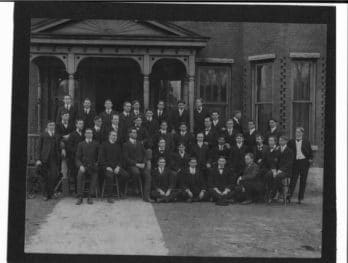DAVIDSON HISTORY
Tragedy at the Medical School

Davidson’s Medical College students, 1903 (photo courtesy of Davidson College Archives)
In 1903, there was a tragic death at the North Carolina Medical College, then located in Davidson. In mid-January of that year, two students, John Mason (J.M.) Boyce of Blacksburg, South Carolina, and C.R. McLeod of Robeson County were dissecting a cadaver. McLeod apparently had a small cut on his hand, and Boyce pricked his finger with a sharp instrument during the dissection. According to a January 27 report in Raleigh’s Farmer and Mechanic: “In twenty-four hours symptoms of septacaemia developed and now the young men are lying at the point of death …Today Dr. Munroe assisted by Dr. Strong, of this city [Raleigh], gave the patients the treatment which is being experimented with in New York, injections of formalin. The first treatment caused a rally in the condition of the patients, but it is believed it was given too late and the doctors have about abandoned hope, though they are still persevering with the formalin.”
By February 3, C.R. McLeod had died after what Wilmington’s Semi-weekly Messenger described as a “strong, brave fight.” The Messenger went on to say that “For two weeks the superb young frame had battled with the ravages of the disease,” but that “he absorbed in his system a poison so dangerous in its initial symptoms as to almost preclude any hope of recovery.” They added that Boyce would probably recover, although Dr. Munroe, the head of the medical school, felt that it would be a long recovery. Boyce did survive, receiving his medical degree in 1903. He later practiced medicine in Polkton and Bessemer City, N.C.
On February 17, the Messenger published what might have been a tongue-in-cheek article about the learning opportunities these tragic events provided those at the medical college. Apparently, Dr. Munroe felt that one of the microbes in the blood of the two students was previously unknown. As an experiment, he injected the known strain involved, “stathyllococci pyoges alba” [Staphylococcus pyogenes albus, now regarded as a mutation of staphylococcus aureus] into a rabbit, whereupon it developed a high fever and a rapid pulse. According to the Messenger, the rabbit’s “principal symptoms are a drooping left ear and a very surprised, sad look. Dr. Munroe, who is at the head of the medical corps which is experimenting with the rabbit, says that rabbit hasn’t one chance in a thousand to recover,” as he had developed septicemia, “Which is incurable even in a rabbit because nobody has given him formalin or packed him in ice to reduce his temperature. His peculiar mission is to develop a respiration that was unheard of in the rabbit family and then to be laid on the dissecting table as a sacrifice at the shrine of the great god of medicine. So far, as has been recorded, only the left ear of the rabbit has drooped; this being a flag of distress that is important to nobody except the rabbit, whose feelings in the matter need not be considered.” Three other rabbits were awaiting injections of the unknown bacteria, which the Messenger described as “so poisonous … that they eat each other ravenously and leave no trace of themselves. The physicians have been laboring to find one of the germs that was not engaged in warfare, or to separate two of them that had already locked jaws in mortal combat, but thus far their efforts have been unavailing.”
Nancy Griffith
Nancy Griffith lived in Davidson from 1979 until 1989. She is the author of numerous books and articles on Arkansas and South Carolina history. She is the author of "Ada Jenkins: The Heart of the Matter," a history of the Ada Jenkins school and center.


